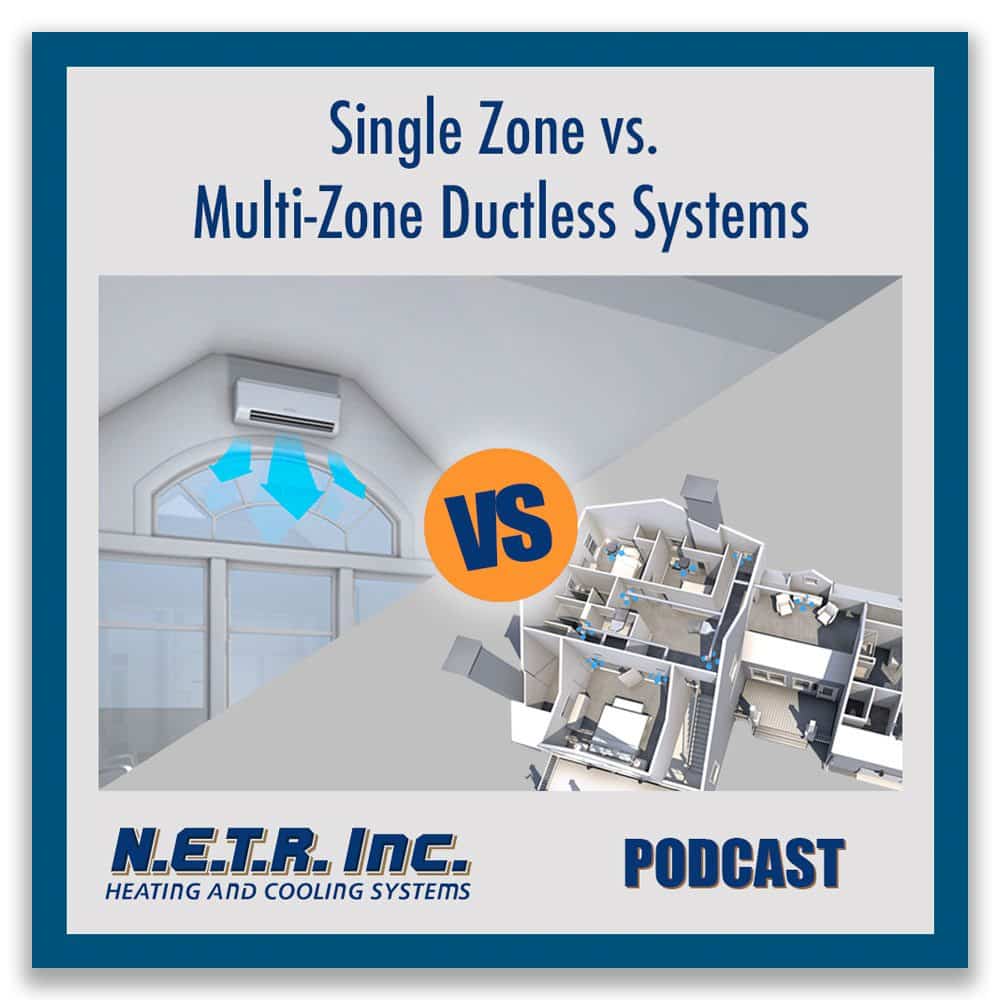Are there areas of your home that are too warm or cold? If so, consider installing a ductless HVAC system. Mike Cappuccio, owner of N.E.T.R., Inc., discusses the differences between a single zone and multi-zone ductless HVAC system and how to choose the best one for your needs. Listen or read more to find out about single zone vs. multi-zone ductless systems.

John Maher: Hi, I’m John Maher. I’m here today with Mike Cappuccio, owner of N.E.T.R., Inc., a heating and cooling company in Massachusetts with the focus on Mitsubishi ductless heating and cooling products. Today, we’re talking about single-zone versus multi-zone ductless systems. Welcome, Mike.
Mike Cappuccio: Good morning, John. How are you?
John: Good. Mike, what is a single-zone ductless system for HVAC?
Mike: Well, it’s exactly what it says, single-zone. It does one zone. It’s basically one indoor unit that goes inside of the home. It’s about 30 inches long, roughly, by about nine inches high by about nine inches off the wall . . . 18 inches a wall, mounts on the wall. We’d drill a hole through the outside to the home and run piping, two pipes, electrical drain to one condenser that would sit outside the home and it would heat or cool one area of the home.
Choosing a Single Zone HVAC System
John: What are some of the situations where you might install a single-zone system?
Mike: A single-zone system is good for addition. You put a little family room off the back of your home or a three-season porch that you want to turn into a four-season porch and put one zone of heating and cooling out there. A home office. A lot of times, I see a home office people do a single-zone in, because they put a lot of equipment into a home office. I know personally, my home office in my own home, one in my home and my office because I have two computers in there, a printer in there, a TV in there if I’m in there working. It gets warm. You have lighting in there and stuff. Your body’s in there.
That one zone gets warm in the house. I found myself . . . I was turning my thermostat down out in the hallway to cool my office off when everyone else wasn’t even home. I’ve got the thermostat set on 65 degrees and it’s 71 in my office. I said, “You know what, I got to put my own zone in my office now.”
John: You’re cooling the whole house just —
Mike: You’re cooling the whole house and I’m only in one room.
John: — be in only one room.
Mike: I’m in there for eight hours, sometimes, working for a day. I’m spending all this energy to run three times of air conditioning. I’m producing 36,000 BTUs of air conditioning in that removing from the home at that point where I only needed 6,000 BTUs to do the room that I was in. I leave that off. I just control my space there and I save 75% of my air conditioning bill in the summertime in that room. I don’t need heat in there because I’m generating heat in there in the wintertime. It’s the perfect example for a single-zone. A lot of people sometimes even do a single-zone.
We go into a home and they have the traditional split ranch, I guess. You have the up, down, come in the stairs, you can go up, you can go down. Downstairs is the family room area. That’s a good spot for a single-zone. Sometimes on the upstairs area, they have the kitchen, living room, dining area. They have a big wall unit in the wall there at one time. Your father would get the saw out on the weekend and cut a hole on the wall and frame it out and throw a big 24,000 BTU wall unit in there that try to cool the whole house off. Sometimes, we just replace those with 124,000 BTU wall mount unit. Nice and quiet in that area now. That’s a very typically installation for a single-zone.
Choosing a Multi-Zone HVAC System
John: Right. Then what is a multi-zone ductless system?
Mike: Multi-zone is, again, exactly what it means is more zone. It’s what you have now is you have one outdoor unit, same as what you would have with the single-zone, but you have one outdoor unit now that can run multiple units inside of the home. We would do one unit in the common area and then we’d put more units into the bedrooms downstairs. We would zone out the home at that point. You can turn off the zone in the common area or the living room, dining room, kitchen.
When you go to bed at night, you can shut that off or turn that back, set the temperature back. Now, you can turn the bedrooms down on the temperature you want, vice versa in daytime and nighttime. That’s how you pick up the efficiency. You’re not cooling the whole entire home and areas where you’re not even in during the day wasting all this energy and money to heat and cool the home in those areas. You can control the temperature in the zones with a multi-zone system.
John: Is that outdoor unit then? Obviously, that must be a bigger unit to people to handle the multiple —
Mike: Yes. When you look at a multi-zone unit versus a single-zone unit — but some of the single-zone units on the bigger side, you get into the 24,000 BTU, 36,000 BTU units, those are about three feet tall by three feet wide. When you get into the bigger multi-zone units where you’re probably running anywhere from four to eight zones, those are about five feet tall by about three feet wide. They do get taller. They’re about the same depth though. It’s deep as a suitcase, I guess, if you would have stand it up, but then the outdoor unit is bigger. Usually, it has two fans on it on the outside versus one fan on the single-zone units.
How to Choose Between a Single Zone and Multi-Zone
John: How do I know what type of system I need for my air conditioning and heating needs?
Mike: Well, we’re going to talk to you a little bit about that when we come out to your home. We’re going to see what your needs are. The question to you that I’m going to ask you is how do you use your home, how do you live in your home, where are you living in your home, what do you do in your home, how many people are in your home, who visits your home, what do you like to do, do you like to entertain, do you not like to entertain? We got to find out your lifestyle. Your lifestyle dictates the type of heating and air conditioning system you need in your home. Sometimes, people don’t think like that, but it really does.
We find out a lot of the times where we go into a home and we’ve got the empty nester. What I mean by the empty nester is all the kids are gone. They’ve got a three-bedroom ranch or that split-level home we were just discussing. They’ve got that open area in the home. They’ve got the bedroom, three bedrooms downstairs. We go in and we look around, they tell me, “Okay. Well, you know what, this is where we live. We live in the kitchen, living room, dining room area, here, and we only use that one bedroom. We only use the master bedroom. Those other two bedrooms, we don’t use those. People are never here or maybe someone visits in the summertime for a couple days here and there.” And it’s like, “Okay. Well, you’re using one bedroom. You’re using the other open area.”
I’m looking at that going, “Okay. That’s a three-zone unit. If you tell me you’re using the office eight hours a day, then, hey, that’s going to go to a four-zone unit.” All depends on how your lifestyle works out, and then budgets obviously come into play with that too. “This is what this one costs. This is what that one costs.” You got to meet the happy medium but I’m going to tell you, a lot of times we see, it’s the three-zone. Three-zone to four-zone unit is what you see in a typical home. When you start to talk to people and understand their lifestyle, that’s what’s going to dictate how they do that home, how they’re going to heat and cool that home.
John: All right. That’s really great information, Mike. Thanks again for speaking with me.
Mike: Thanks, John.
John: For more information, visit the N.E.T.R., Inc. website at NETRInc.com or call 781-933-NETR. That’s 781-933-6387.

